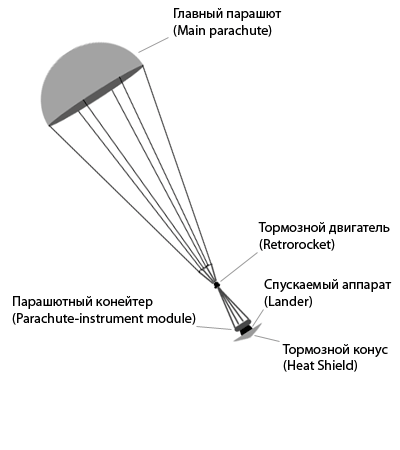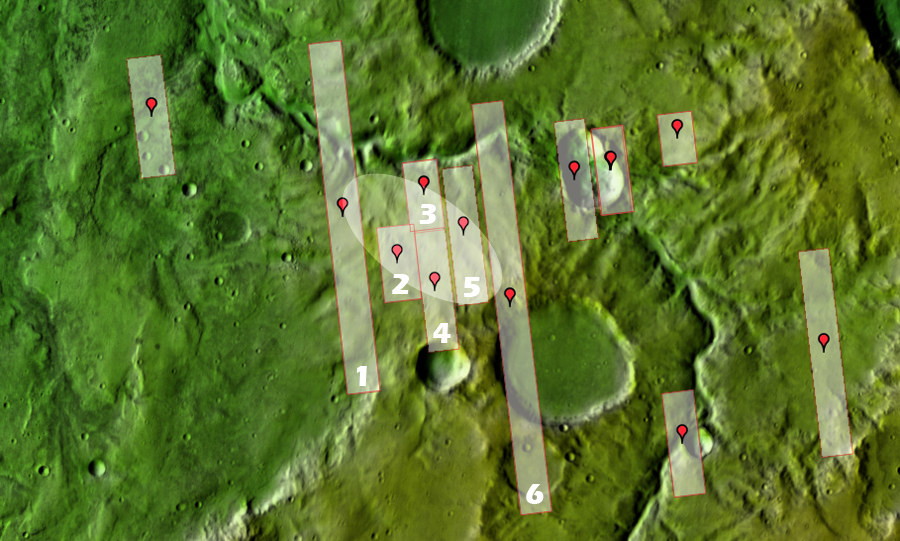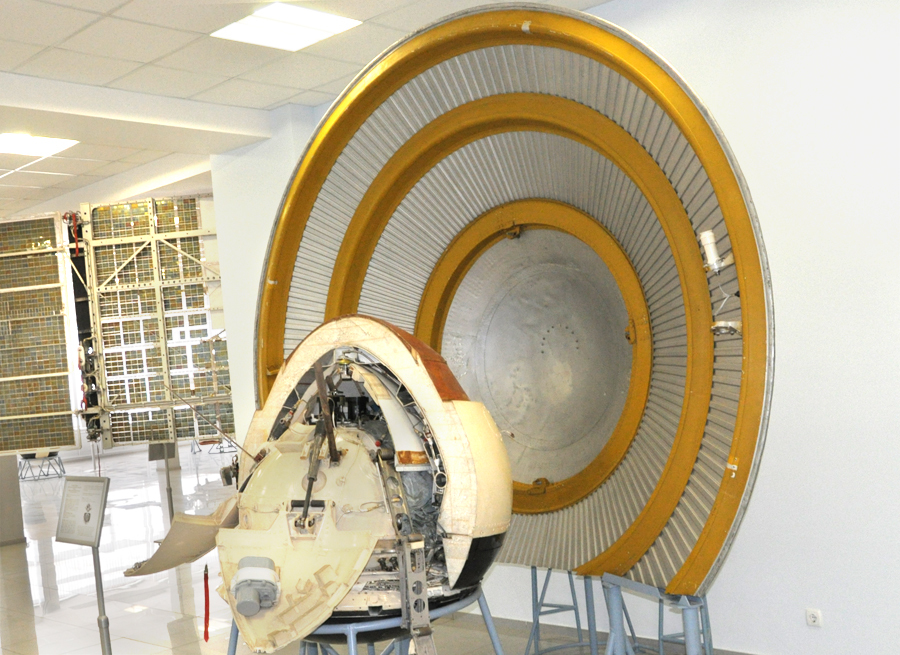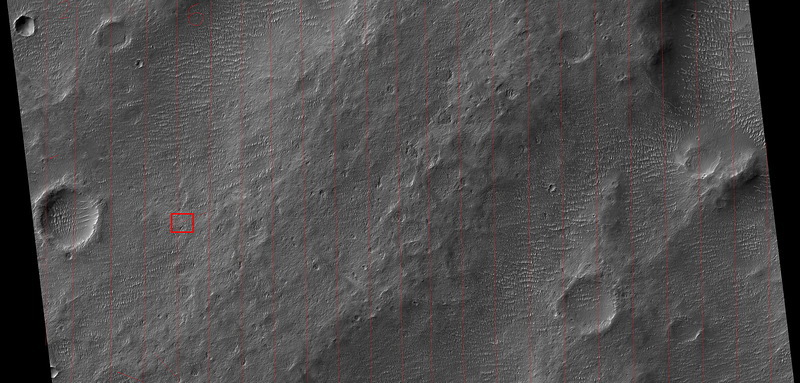We are looking for Mars-6
 Exactly 40 years ago, the Mars-6 Soviet research apparatus entered the atmosphere of Mars. His speed in outer space was 5.8 kilometers per second, and in a matter of minutes he needed to quench it to zero. Even the thin atmosphere of Mars - at 1% of the Earth - is a significant difficulty for landing. It is too dense to ignore, and too thin to entrust a soft landing only to a parachute. In general, the landing scheme of our "Mars" corresponded to all subsequent missions.
Exactly 40 years ago, the Mars-6 Soviet research apparatus entered the atmosphere of Mars. His speed in outer space was 5.8 kilometers per second, and in a matter of minutes he needed to quench it to zero. Even the thin atmosphere of Mars - at 1% of the Earth - is a significant difficulty for landing. It is too dense to ignore, and too thin to entrust a soft landing only to a parachute. In general, the landing scheme of our "Mars" corresponded to all subsequent missions.The first blow of the dense layers of the atmosphere took over the brake cone - the “umbrella” which protected the apparatus from the shock wave caused by the invasion of the Soviets into the Primarisian expanses. At a speed of about 1 kilometer per second, a small deceleration parachute opened, then the main one. At this stage of the descent, Mars-6 began the first research, the most important of which was the analysis of the composition of the atmosphere. Although this analysis turned out to be very exemplary, its importance is that this is the first direct study of the Martian atmosphere. However, this is the only merit that this device can boast of. At the final stage of the descent - when the brake motors were supposed to completely stop the vehicle a few meters from the surface - the connection was interrupted. Whether they were able to stop it or the radio altimeter made a mistake in determining the height, and the device crashed, it is not known until today.
As conceived by the designers, the landing should have been done as follows:

')
But what happened in reality is the question. And today we can try to solve the interplanetary riddle forty years ago.
The possibility of independent research of Mars became a reality when the NASA Mars Reconnaissance Orbiter satellite entered its orbit. He surveys the surface with details up to 25 cm per pixel, a high-resolution HiRise camera , and the results of the survey are laid out in open access .

A year ago, with his help, we found "Mars-3" . This is the predecessor of Mars-6, which touched the surface of the Red Planet in 1971. He sat down successfully, but worked only 14 seconds.

Success with the "Mars-3" inspired by new searches. But now the task is complicated almost tenfold.
Satellite MRO made a series of frames of the proposed landing site "Mars-6". The surface area covered by these frames is 964.5 square kilometers. There may be a parachute, a brake shield and the descent vehicle itself. But there is no 100% guarantee that the desired objects appeared on these frames. If we look through all the fragments and find nothing similar, then we turn to NASA asking them to remove the missing fragments of the whole territory. But even this does not guarantee the success of our searches: if an error crept into the calculations of Soviet ballistics, or they did not take into account any factors, the Mars-6 flew to a place where no one thought to look for it.

On this map of Mars, long rectangles represent areas that were shot by a HiRise camera at a resolution of 25 to 53 centimeters per pixel. This means that the Mars-6 descent vehicle will have dimensions from 6-7 to 3-4 pixels. The white ellipse is the intended region where our probe could have landed. The reduction of the apparatus occurred in the southeast direction. Numbered rectangles are those images, fragments of which we view. Obviously, to find an object and a half meter on this area is not an easy task. Therefore, we share the burden on all comers.
"Mars-6" structurally largely repeated its predecessor "Mars-3", outwardly, they practically did not differ. In the photo we can see the brake cone (heat shield), foam casing and the unit itself. Whether Mars 6 could open its petals or remained in the "egg" is not known.

Below are links to fragments of satellite images that can be downloaded and viewed. The most convenient way is to put a 150–200% increase (no more, but instead of searching, a contest for the most vivid imagination will begin) You can slightly increase the brightness and contrast of the picture - as it is more convenient for the eyes. But not much, but then again the imagination will see that which is not.
It is best to browse right-left or up-down. In Photoshop, I divide the frame along the width of the monitor.

I recommend to first write in the comments, who downloaded and viewed what fragment. If something suspicious or curious comes up, take a screenshot and post a snapshot in the same comment thread. In the caption, specify the fragment number, and the exact location of the found object: in words or coordinates in pixels:

Earlier, I was hoping that it would be possible to create a mobile application to search for missing vehicles, but the attempt was not successful. Yes, and such a system would make the discovery impersonal, so I decided to continue like this: primitive and manually. But if someone decides to write a program to automatically search, I will not mind. Even curious to compare the results.
Explanations of what and how you can search on Mars, I wrote separately .
In LiveJournal, we already looked at the first four frames, so I recommend paying attention to the last two. But a single view is not enough to consider verification reliable. On a separate page , which one enthusiast created at his own initiative, one can already see some of the objects found.
Who ridonly, you can post the finds here .
So, welcome to Mars:
Frame 1
The pixel size is 53 cm.
The descent vehicle will be only 3 pixels in size (the chance to find almost zero)
parachute - up to 13 pixels
brake shield - up to 7 pixels.
Fragments of 25-30 MB:
1-1 , 1-2 , 1-3 , 1-4 , 1-5 , 1-6 , 1-7 , 1-8 , 1-9 , 1-10 , 1-11 , 1-12 , 1- 13 , 1-14 , 1-15 , 1-16 , 1-17 , 1-18 , 1-19 , 1-20 ,
Fragments of 10 MB:
1-21 , 1-22 , 1-23 , 1-24
Frame 2
The pixel size is 28.2 cm
The device - up to 6 pixels
parachute - up to 20 pixels
brake shield - up to 12 pixels
Fragments of 30-40 mb:
2-1 , 2-2 , 2-3 , 2-4 , 2-5, 2-6 , 2-7 , 2-8 ,
Fragments of 10-15 MB:
2-9 , 2-10 , 2-11 , 2-12 , 2-13 .
Frame 3
The pixel size is 25.9 cm.
The device will be up to 6 pixels
parachute - up to 23 pixels,
brake shield - up to 11 pixels.
Fragments of 25-30 MB:
3-1 , 3-2 , 3-3 , 3-4 , 3-5 , 3-6 , 3-7 , 3-8 , 3-9 , 3-10 , 3-11 .
Frame 4
Pixel size 25.8 cm
The device - up to 6 pixels
parachute - up to 23 pixels,
brake shield - up to 11 pixels
Fragments of 30-40 mb:
4-1 , 4-2 , 4-3 , 4-4 , 4-5 , 4-6 , 4-7 , 4-8 , 4-9 , 4-10 , 4-11 , 4-12 , 4- 13 , 4-14 , 4-15 .
Frame 5
Pixel size 51.8 cm
The device - up to 4 pixels
parachute - up to 14 pixels
brake shield - up to 7 pixels
Fragments of 30-40 mb:
5-1 , 5-2 , 5-3 , 5-4 , 5-5, 5-6 , 5-7 , 5-8 ,
Frame 6
The pixel size is 51.7 cm.
The device - up to 4 pixels
parachute - up to 14 pixels
brake shield - up to 7 pixels
Fragments of 12-16 mb:
6-1 , 6-2 , 6-3 , 6-4 , 6-5 , 6-6 , 6-7 , 6-8 , 6-9 , 6-10 , 6-11 , 6-12 , 6- 13 , 6-14 , 6-15 , 6-16 , 6-17 , 6-18 , 6-19 , 6-20 ,
6-21 , 6-22 , 6-23 , 6-24 , 6-25
Thank you for your help in organizing the search for an NGO. S.A. Lavochkin, and personally the general director of the enterprise, Viktor Hartov, who immediately demonstrated his willingness to assist in the search for Mars-6 and popularize the national cosmonautics. Thanks to the press service of the Space Research Institute of the Russian Academy of Sciences, for informational support. I hope we have one of the first, but not the last example of the collaboration of official space organizations with cosmonautics enthusiasts from the Internet.
Source: https://habr.com/ru/post/215433/
All Articles